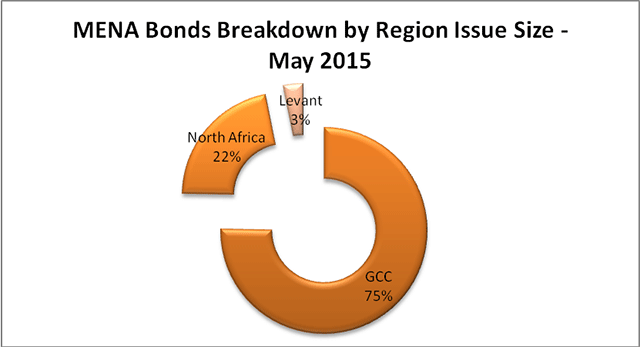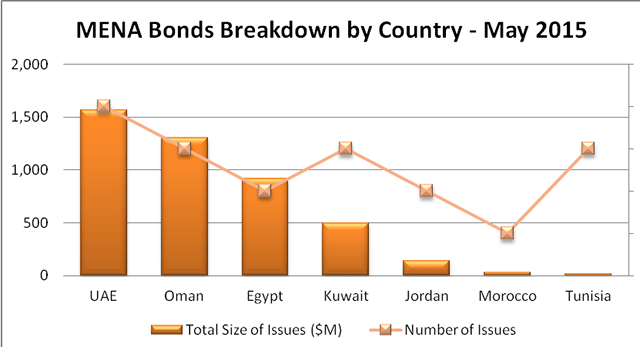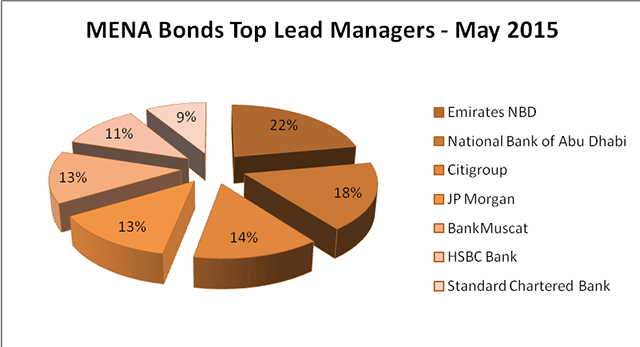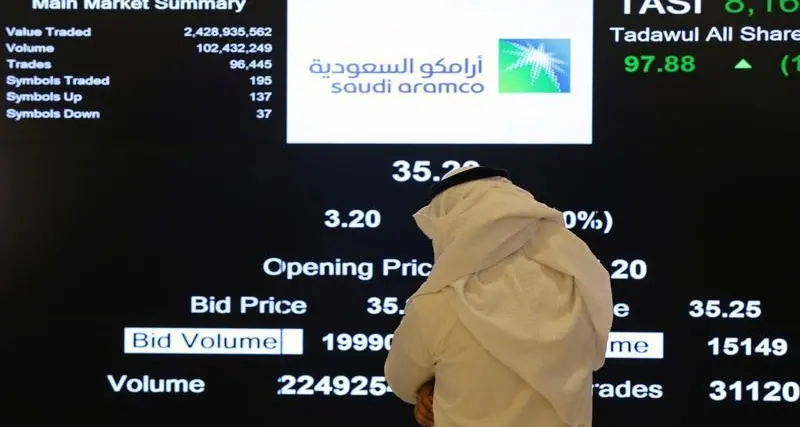The number of bond issuances in the Middle East and North Africa sagged in May as the region continued to be roiled by political turmoil, and activity is expected to slow down further during the holy month of Ramadan.
But the market is set for a strong recovery in August, powered by sovereign Eurobonds aimed at covering state budget deficits and financing growth plans.
The MENA conventional bonds market raised USD 4.47 billion through 18 bonds in May, down 13% in terms of issue size compared with the previous month.
The GCC region led with USD 3.36 billion raised through 10 issues, followed by North Africa with USD 964 million via six issues and the Levant region with USD 141 million from two issues.
Source: Zawya Bonds Monitor
The UAE was the largest issuer, representing 35% of total value, followed by Oman (29%), Egypt (20.5%), Kuwait (11%), Jordan (3%), Morocco (1%) and Tunisia (0.5%).
Oman Electricity Transmission Company issued the largest Eurobond in May, worth USD 1 billion and paying a 3.958% semiannual fixed coupon rate. The issuance, which matures in 2025, was listed on the Irish Stock Exchange. JP Morgan and Bank Muscat acted as the lead managers of the bond rated A3 by Moody's.
The second largest issuance was a Eurobond issued by DP World worth USD 500 million, paying a 3.25% semiannual fixed coupon rate and maturing in 2020. The issuance was listed on London Stock Exchange and was oversubscribed seven times. The issuer mandated Citigroup, Deutsche Bank, Emirates NBD, HSBC, National Bank of Abu Dhabi and Societe Generale for the issuance.
The third largest issuance was an international bond from the Industrial and Commercial Bank of China worth USD 500 million, which pays a 2.625% semiannual fixed coupon rate and matures in 2020. The seven times-oversubscribed bond, rated A1 by Moody's, was listed on Nasdaq Dubai and Irish Stock Exchange. The issuer mandated Citigroup, Emirates NBD, National bank of Abu Dhabi and itself for the issuance.
Source: Zawya Bonds Monitor
Bond Analysis
Sovereign bonds led the MENA capital market in terms of value, with eight issues worth a total of USD 2.55 billion, followed by corporate bonds which raised USD 1.91billion via 10 issues.
In terms of sectors, governmental instituitions accounted for 35% of the total raised from seven issues, followed by financial services with 31% via eight bonds, power and utilities with 22% from one issue, transport with 11% from a single issue and food and beverages with 1% from a sole issuance.
International bonds represented 64% of the total issue size at USD 2.86 billion from six issuances, while domestic bonds followed with 36% at USD 1.60 billion from 12 bonds.
The USD led the market with 59% of the total issue size backed by international bonds, followed by EGP (21%), KWD (11%), CHF (5%), JOD (3%), and 1% for the TND, MAD and OMR combined.
In terms of overall size of issues, Irish Stock Exchange came first with listings at USD 1.8 billion, followed by Egyptian Stock Exchange with USD 917 million, Nasdaq Dubai with USD 850 million, London Stock Exchange with USD 500 million, Luxembourg Stock Exchange with USD 350 million, Swiss Stock Exchange with USD 214 million, Amman Stock Exchange with USD 141 million, Tunis Stock Exchange with USD 15 million and Muscat Securities Market with USD 4.7 million.
Source: Zawya Bonds Monitor
Emirates NBD was the most active lead manager in May for a total amount of USD 1.65 billion via four issues, followed by National Bank of Abu Dhabi with USD 1.3 billion via three issues, Citigroup with USD 1 billion via two issues, JP Morgan and Bank Muscat with USD 1 billion from one issue each, HSBC with USD 850 million via two issues and Standard Chartered with USD 650 million from two issues.
The market is expected to shrink during the fasting month of Ramadan, which starts in mid-June, before making a significant comeback in August.
© Zawya 2015











